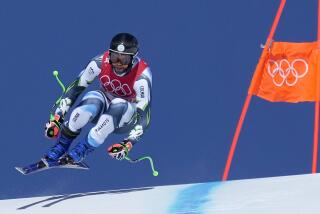Luger killed in sled crash during Olympic practice run
Reporting from Whistler, Canada — Just hours before the caldron was lighted to mark the start of these Winter Olympics, a young athlete’s life was snuffed out in a horrific crash on the world’s fastest luge track.
On a morning training run under the first blue sky in days, Nodar Kumaritashvili, 21, of the Republic of Georgia lost control of his sled at about 80 mph as he came out of the final curve -- nicknamed Thunderbird -- and approached the finish line. He catapulted over the outer lip of the track and slammed into an unpadded roof support post.
Track and medical workers began performing CPR as an ambulance parked nearby raced to the scene. Kumaritashvili was motionless as he was loaded onto a stretcher. The venue’s video screens replaced live images with an Olympic logo.
The Georgian was taken by an air-rescue helicopter to the Whistler trauma center, where he was pronounced dead.
He is the third training fatality in Winter Olympics history.
Athletes quickly left the Whistler Sliding Centre and shaken track workers and volunteers gave each other bearhugs. Royal Canadian Mounted Police officers cordoned off the accident site, and training was suspended on the year-old track as Olympic officials met to review the situation. Late Friday, after the Coroners Service of British Columbia concluded its investigation, it turned the track over to the luge federation.
It issued this statement:
“It appears after a routine run, the athlete came late out of curve 15 and did not compensate properly to make correct entrance into curve 16. This resulted in a late entrance into curve 16 and although the athlete worked to correct the problem he eventually lost control of the sled resulting in the tragic accident. The technical officials of the FIL were able to retrace the path of the athlete and concluded there was no indication that the accident was caused by deficiencies in the track.”
The track will reopen Saturday for practice followed by competition at 5 p.m.
Luge is a highly technical sport that requires precision driving. Elite athletes take years to develop, and many of the best are in their mid- to late 30s.
It would have been difficult for Kumaritashvili, who has been competing at the elite level for only two seasons, to have mastered the track’s intricacies. Last season, he competed in five of eight World Cup races and was ranked 44th, a 10-place improvement over his rookie year.
He crashed in an earlier training run. Even so, he averaged 89.4 mph over four completed runs.
At a hastily called news conference in Vancouver, Jacques Rogge, president of the International Olympic Committee, struggled with his composure.
“It is hard to stay composed,” Rogge said, his voice cracking. “It’s a very sad day. The IOC is in deep mourning. Here you have a young athlete who died pursuing his passion. I have no words to say what we feel.”
Rogge turned aside questions about the future of the competition, saying he would await the results of the investigation. He also sidestepped whether Kumaritashvili lacked the experience to be sliding on the track.
“This is a time for sorrow. It is not a time to look for reasons,” he said.
It is possible to reduce the track’s speed by adjusting the temperature and adding frost. But the allure of this year’s luge competition -- and the bobsled and skeleton events that also are held here -- is the fact that the world’s best athletes are trying to tame a course that has bested most of them to this point.
Armin Zoeggeler, the two-time Olympic gold medalist from Italy, crashed in training. Germany’s Felix Loch, considered a medal favorite, injured his shoulder last November during international training week.
During a Thursday training run, Romanian slider Violeta Stramaturaru was briefly knocked unconscious and required medical treatment.
John Rosen, an official with the U.S. Bobsled and Skeleton Federation, was working as a course volunteer when the accident occurred. “The tracks are designed to capture the athletes,” Rosen said. “The fact that someone could fly out of the track is extremely rare. This was just a tragic accident. These are dangerous sports, but serious accidents are rare.”
Athletes have been circumspect in discussing the dangers and whether track designers have pushed athletes and equipment beyond the breaking point.
But Thursday evening, after she nearly crashed in a training run, Australia’s Hannah Campbell-Pegg spoke out.
“I think they are pushing it a little too much,” she said. “To what extent are we just little lemmings that they just throw down a track and we’re crash-test dummies? I mean, this is our lives.”
Philip Hersh and freelance reporter Meri-Jo Borzilleri contributed to this report.
More to Read
Go beyond the scoreboard
Get the latest on L.A.'s teams in the daily Sports Report newsletter.
You may occasionally receive promotional content from the Los Angeles Times.





